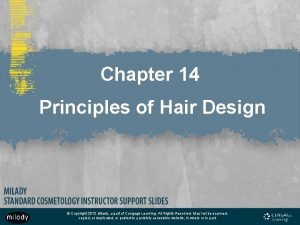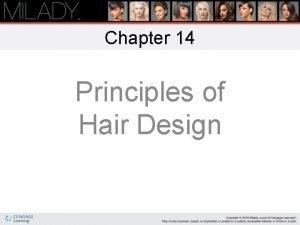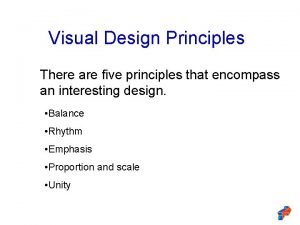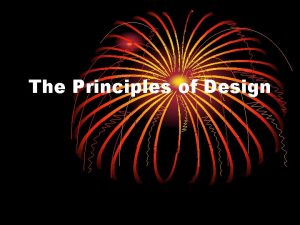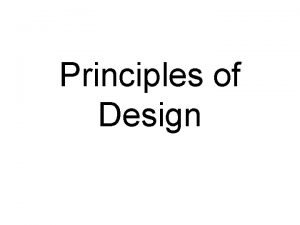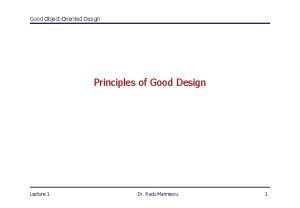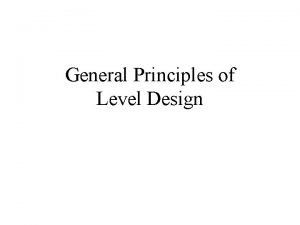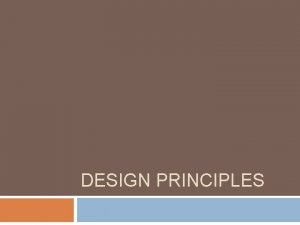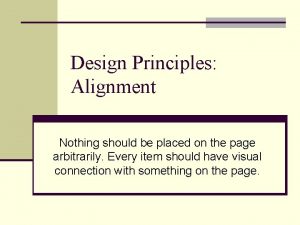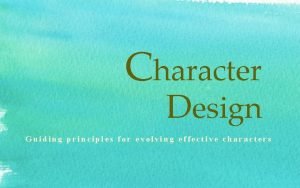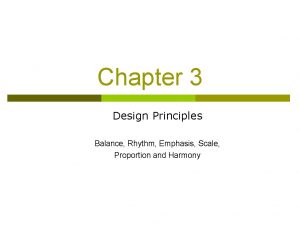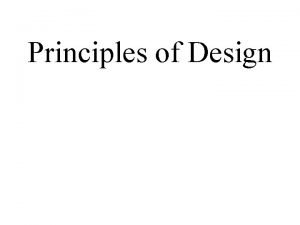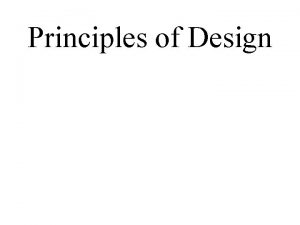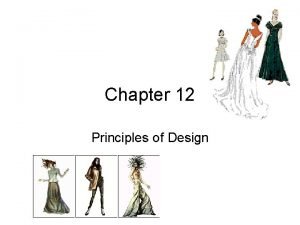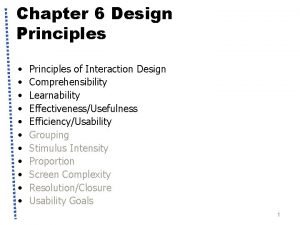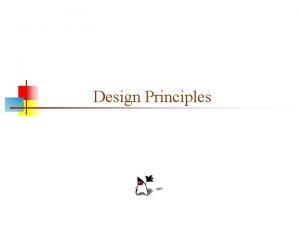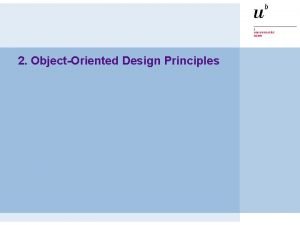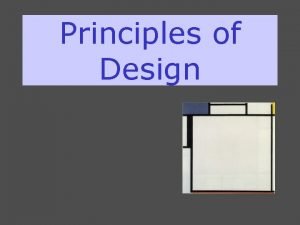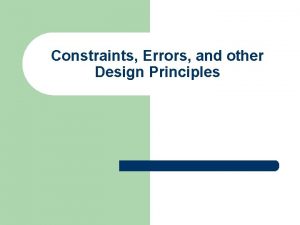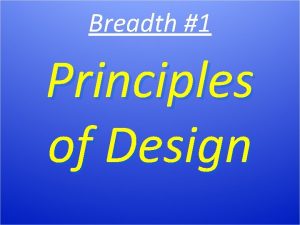Chapter 2 Principles of Design Principles of Design

















































- Slides: 49

Chapter 2 Principles of Design

Principles of Design

I. History of Floral Design § A. Flower arranging is a work of art.

We follow certain guidelines § to properly arrange flowers so that they become a “work of art”. These guidelines are called principles of design.

Basic laws § fundamentals, truths or methods of operation that have been tested and proven for many centuries.

Arrangements § are judged by these principles. § Tools that will guide in planning and evaluating arrangements.

Concepts of floral design § Two concepts developed independently of each other. § Occidental Style – evolved in Egyptian and Middle Eastern Cultures § further developed by the Europeans

Oriental Style § began in China § later explored by the Japanese

Egyptian Period § 2800 -28 BC § arranged separate rows of different colored flowers in shallow bowls

Egyptian period § feast tables were often decorated with fruits and vegetables neatly piled in low baskets

Egyptian Period § several flowers were considered sacred, symbolizing Egyptian Gods and Goddesses § Lotus and Water Lillies were placed in elaborate vases, bowls and jars

Ancient Greeks § 600 -146 BC § Did not arrange flowers in vases, scattered blossoms on tables and on the streets

Ancient Greeks § flowers were used to make garland wreaths worn during special occasions. § Presented as awards to athletes, statesmen and soldiers.

Ancient Greeks § the cornucopia (horn or plenty) was filled with fruits and vegetables and placed in an upright position rather than on its side as done today

Romans § 28 BC - 325 AD § continued the customs of the Greeks § arrangements and usage became more elaborate

Romans § scatter roses on banquet tables and on the floor § scarves filled with blossoms were offered at an altar in Roman Religious Ceremonies

Romans § Wreaths and Garlands became more elaborate

Byzantine Period § 320 -600 AD § arrangements of cut flowers used again § formal conical designs with clusters of blossoms at regular intervals

Middle Ages § 476 -1600 AD § very little is known about floral designs of this time period

Renaissance § 1400 -1600 AD § beautifully documented in paintings § designs were large, tall, pyramidal, and symmetrically balanced

Renaissance § flower arrangements were loose, un-crowded and airy § formal bouquets featured the most important flower situated centrally, at the top of the bouquet, with other flower heads turned outward.

Renaissance § flowers were arranged so that they were about twice the height of the container § intense colors were used to create contrast with the white plastered walls of buildings

Renaissance § several traditional floral designs of today are styled after renaissance arrangements

Baroque Period § began as symmetrical, oval shaped designs § asymmetrical curves in the shape of a crescent or an “s” were adopted later

Baroque § an abundance of flower types and colors were used together § arrangements incorporated a variety of accessories such as figurines and butterflies

Baroque § the “s” curve and crescent arrangements developed during this period are popular today

Flemish-style § 1600 -1750 AD § beautifully captured by Dutch painters § traditional baroque styles were refined

Flemish style § refined - not as loose and open § better proportioned and more compact § Rich colors and an array of flowers were combined into masses, oval shape bouquets.

Flemish style § The French developed mass arrangements during the same time that were lighter and more airy than those of the Dutch. § Arrangements were made from delicate flowers in light pastel colors.

Georgian period § 1714 -1760 A. D. § Time period that spanned the reigns of the English kings George I and George II § Arrangements were greatly influenced by Chinese arts.

Georgian period § Usually symmetrical and triangularly shaped. § Many featured a single flower type. § Designs moved away from formality and symmetry in the

Georgian period § nosegay, or handheld bouquet became stylish § small nosegay bouquets placed in bowls were the first use of table centerpieces as we know them today.

Georgian period § Georgian art influenced the decorative arts in Colonial America. § Fan shaped and triangular arrangements were made and sometimes placed the center of interest near the rim of the container.

Georgian period § boxwood, ivy, and magnolia were used with garden flowers in the summer § berries, cones, greens with fruit were used during the winter along with dried flowers.

Victorian period § 1820 -1914 A. D. § Flowers were fashionable but designs were rather unappealing. § Improperly proportioned

Victorian period § large amounts of flowers cramped into a container to create a compact arrangement § usually asymmetrical with no focal point.

Victorian period § many different flower types and colors used, arrangements looked unplanned. § Rules for flower arranging were established toward the end of the Victorian period.

Oriental Style § Began in India where Buddist priests scattered branches and stem on altar or placed them in pottery urns. § Modified by the Chinese during the first century A. D.

Oriental Style § Arranged flowers in massive bronze vessels § Felt it was improper to place flowers carelessly on the altar. § Created symbolic arrangements § Bright colors were favored.

Oriental Style § Usually large and symmetrical with one or two types of foliage and flowers placed around a central branch. § Lightest colors were used at outer portions of design, darker ones kept nearest the base.

Oriental Style § Sixth Century A. D. Japanese adopted many aspects of the Chinese culture, including floral arrangement. § Japanese priest named Ikenabo refined the art.

Oriental Style § His instruction was sought by other Buddhist priests. § Began the first school of floral art in Japan which bears his name.

Oriental Style § Name later changed to Ikebana which means “giving life to the flowers. ”

Oriental Style § Many schools of Japanese flower arrangements have evolved from this original one, the basic principles can be traced back to Ikenaba.

Oriental Style § Japanese designs are characterized by minimum use of plant material and careful placement of branches and flowers. § Each placement and angle has meaning.

Oriental Style § This type of arrangement became known as “line arrangement”

European Style § generally large, round or oval mass of flowers § flower placement is not rigidly dictated as in oriental design

European Style § known as mass arrangements § most floral designs in the US are referred to as “line mass” and combine Oriental and European ideas

European Style § American floral design uses more materials than the Oriental but far fewer than the European § US floral design is often built around linear patterns, showing the Oriental influence.
 Interior design lecture notes+ppt
Interior design lecture notes+ppt Contrasting lines in hair
Contrasting lines in hair Smooth directional wave patterns
Smooth directional wave patterns Five principles that encompass an interesting design.
Five principles that encompass an interesting design. Input design principles
Input design principles 11 principles of design
11 principles of design Principles of design radial balance
Principles of design radial balance Is a consistent, orderly or pleasing arrangement of parts.
Is a consistent, orderly or pleasing arrangement of parts. What is the first design principal of mips?
What is the first design principal of mips? Operating system design principles
Operating system design principles What are the four basic principles of document design
What are the four basic principles of document design Graphical user interface design principles
Graphical user interface design principles Software design fundamentals in software engineering
Software design fundamentals in software engineering Sanitary design principles
Sanitary design principles Protheros cone theory
Protheros cone theory Prinsip dasar desain interaksi
Prinsip dasar desain interaksi Rpd design
Rpd design Drawing removable partial denture design
Drawing removable partial denture design Magazine cover design for school project
Magazine cover design for school project Which type of lines are used in the one-length hairstyle
Which type of lines are used in the one-length hairstyle Principles of furniture design
Principles of furniture design Experimental design principles
Experimental design principles Principles of design proportion
Principles of design proportion Six principles of design
Six principles of design Crap principles of design
Crap principles of design Postmodern design principles
Postmodern design principles Flap design principles
Flap design principles Operating system internals and design principles
Operating system internals and design principles Design principles of unix operating system
Design principles of unix operating system Minecraft design principles
Minecraft design principles 7 principles of microservices
7 principles of microservices Postmodern art principles
Postmodern art principles Channelization in traffic engineering
Channelization in traffic engineering Design elements hair
Design elements hair Good interface design
Good interface design A 2d area enclosed by lines or curves
A 2d area enclosed by lines or curves Principles of level design
Principles of level design Level design principles
Level design principles Transition floral design definition
Transition floral design definition Elements and principles of design chart
Elements and principles of design chart Elements and principles design matrix
Elements and principles design matrix A feeling of visual equality
A feeling of visual equality Design principles for web connectivity
Design principles for web connectivity Contrast repetition alignment proximity examples
Contrast repetition alignment proximity examples Design principles alignment
Design principles alignment Don norman mapping
Don norman mapping Engineering principles of design
Engineering principles of design Principles of character design
Principles of character design What are the three principles of user-centered design?
What are the three principles of user-centered design? Design principles balance
Design principles balance

